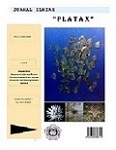Bacillus sp. As a Decomposition Agent in The Maintenance of Brachionus rotundiformis Which Uses Raw Fish As a Source of Nutrition
DOI:
https://doi.org/10.35800/jip.7.1.2019.22627Abstract
The research was conducted at the Laboratory of Marine Molecular Biology and Pharmacy, Faculty of Fisheries and Marine Sciences, Sam Ratulangi University. This research aims to isolate and analyze the morphology and molecular types of bacteria associated in rotifer’s culture media that use fisheries waste.
The research was begin by culturing bacteria in rotifer maintenance media using Nutrient Broth media. After bacterial isolates were obtained, morphological characterization and DNA extraction was carried out. extraction was done using DNeasy Blood and Tissue Kit (Qiagen). After DNA was obtained, DNA was amplified through the Polymerase Reaction Chain (PCR) machine using a 16S RNA primer, followed by the separation of PCR products through electrophoresis and detection through UV Transluminator. The target PCR product was determined by comparing the 100 bp ladder DNA, with a yield of around 1400 bp, which was measured using ladder DNA available in the laboratory. The DNA that was successfully amplified was sent to be sequenced to determine the species of each microbe obtained.
Based on the results of the research conducted, obtained Bacillus sp. bacteria associated with rotifer maintenance media.
Keywords: Bacteria, Culture Media, DNA Extraction, PCR, Sequencing
Â
ABSTRAK
Penelitian ini dilakukan di Laboratorium Biologi Molekuler dan Farmasetika Laut, Fakultas Perikanan dan Ilmu Kelautan, Universitas Sam Ratulangi. Penelitian ini bertujuan untuk mengisolasi dan menganalisis morfologi dan molekuler jenis-jenis bakteri yang berasosiasi dalam media pemeliharaan rotifer yang menggunakan limbah perikanan.
Penelitian dilakukan dengan cara mengkultur bakteri yang ada pada media pemeliharaan rotifer menggunakan media Nutrient Broth. Setelah isolat bakteri didapatkan, dilakukan karakterisasi morfologi dan dilakukan ekstraksi DNA. ekstraksi dilakukan menggunakan DNeasy Blood and Tissue Kit (Qiagen). Setelah DNA didapatkan, DNA diamplifikasi melalui mesin Polymerase Reaction Chain (PCR) menggunakan primer 16S RNA, diikuti dengan pemisahan produk PCR melalui electrophorisis dan deteksi melalui UV Transluminator. Produk PCR target ditentukan dengan membandingkan ladder DNA 100 bp, dengan hasil sekitar 1400 bp, yang diukur menggunakan ladder DNA yang tersedia di laboratorium. DNA yang berhasil diamplifikasi, dikirim untuk dilakukan sekuensing untuk mengetahui spesies dari setiap mikroba yang didapatkan. Berdasarkan hasil penelitian yang dilakukan, diperoleh bakteri Bacillus sp. yang berasosiasi pada media pemeliharaan rotifer.Â
Kata Kunci: Bakteri, Media Pemeliharaan, Ekstraksi DNA, PCR, SekuensingDownloads
Published
How to Cite
Issue
Section
License
COPYRIGHT
Authors who publish with this journal agree to the following terms:
Authors hold their copyright and grant this journal the privilege of first publication, with the work simultaneously licensed under a Creative Commons Attribution License that permits others to impart the work with an acknowledgment of the work's origin and initial publication by this journal.
Authors can enter into separate or additional contractual arrangements for the non-exclusive distribution of the journal's published version of the work (for example, post it to an institutional repository or publish it in a book), with an acknowledgment of its underlying publication in this journal.
Authors are permitted and encouraged to post their work online (for example, in institutional repositories or on their website) as it can lead to productive exchanges, as well as earlier and greater citation of the published work (See The Effect of Open Access).




















